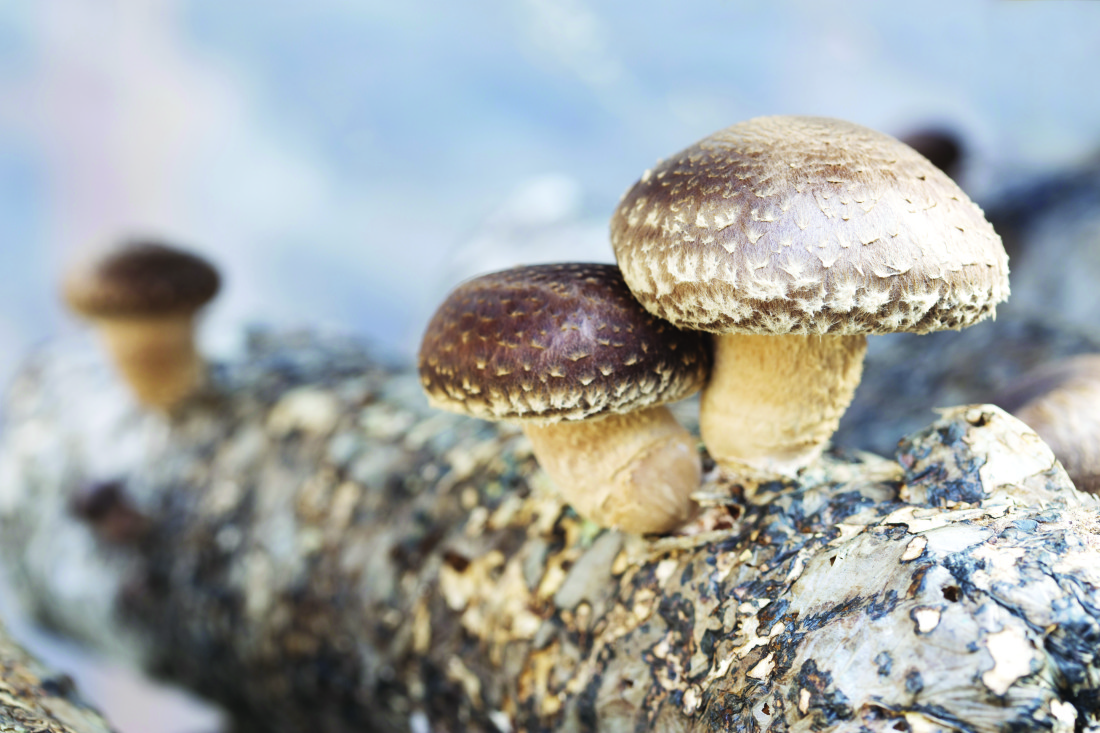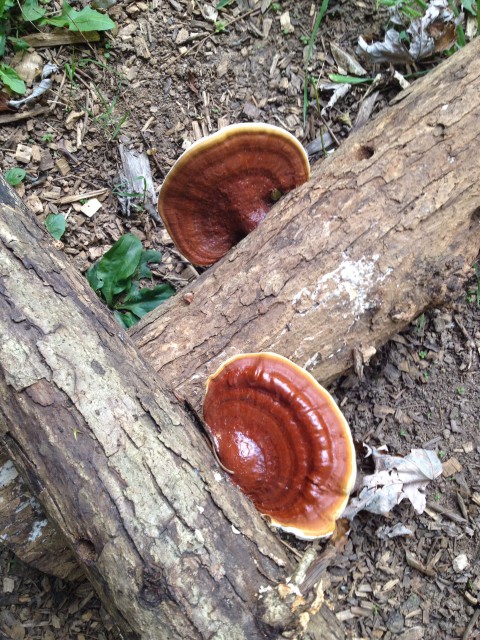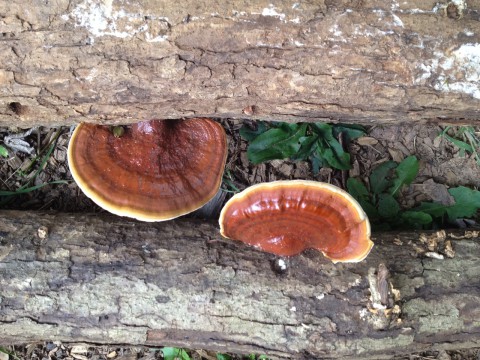Looking for an unusual growing project to carry you through the winter? Ever wish you could have your own shiitake farm or reishi supply? Joseph Allawos, professor of biology at A-B Tech and former co-owner at Asheville Fungi, guides us through cultivating mushrooms on logs in your backyard.
Mountain Xpress: How did you become interested in growing mushrooms?
Allawos: I have a graduate degree in botany, and I’ve always been a plant guy. I became fascinated with mushrooms because I just wanted to figure out how to do this, how to grow mushrooms. In a sense it’s not that easy.
What do you think are the challenges of cultivating mushrooms?
They’re not like plants, so I don’t understand them as well. Plants are a little bit easier to understand in terms of cultivation, from my perspective. [Fungi] are difficult to see. Until you get a fruiting body, it can be difficult to know what you have. Sometimes you start with fuzzy white stuff and you think you know what it is, but it may not be what you think. Whereas with a plant, it’s a little more tangible.
Is there a danger in that?
Not really. The main danger with mushrooms is if you were to collect wild mushrooms and eat them. That’s the real danger. With cultivation, if you do it wrong, you’re more than likely just going to end up with mold. Mold, for the most part, on this kind of level, is harmless. Even if you somehow consumed a little, it probably wouldn’t hurt you. Growing mushrooms is currently unregulated, which tells you it must be pretty safe. It’s considered a commodity like lettuce or broccoli. There’s no USDA intervention with growing mushrooms.
To focus on log growing, are there any specific types of wood you look for if you’re wanting to build your own log?
Sure, and it’s important to point out that growing mushrooms on logs is probably the easiest way you can do it as an individual. It becomes more difficult when you start getting into bags and other types of culture techniques.
So, generally speaking, you look for hardwood species, and oak is considered at the top of the list. A lot of people think this is because it’s a dense wood — which does have a lot of food value for the fungus, which is good — but the real reason we choose oak is because the bark tends to stay on the log for a long period of time. And that’s really what you need. Species of wood that have thin bark, or bark that falls readily off the log as it decomposes, aren’t as suitable because that bark is really what is protecting the fungus inside. So that’s why we choose oak — and it doesn’t matter what kind of oak. Any oak is suitable for just about any species.
But at the same time, it is more complicated than that, and it does depend on the species you are growing. Most people use shiitakes as the example because they are the most commonly cultivated on logs and the easiest to cultivate. For shiitakes, oak certainly would be the best.
So when you have a piece of wood and you’re wondering, “Can I turn this into a log for growing mushrooms,” do you need to be looking for anything in the condition of the wood?
Yes, the condition of the wood needs to be that it is a freshly cut tree. Ideally, it’s cut in the dead of winter. Again, there’s some misconceptions about this. A lot of people say, “You cut it in the winter because there’s more sap in it,” and that’s not really true. Again, it has to do with the bark. If you cut the tree during the growing season, say in the spring, then the bark will peel right off it, which is not what you want. If you cut it when the tree is dormant, the bark tends to stay on a little bit better.
So you’re looking at freshly cut trees, preferably of oak, though other hardwoods will work. It’s almost easier to talk about what won’t work: What won’t work is black locust, any sort of cedar, because it’s so rot-resistant, and most pines. Pretty much any other species would work at least marginally.
When you’re cutting the log, what size do you recommend?
It really depends on if you’re talking about a commercial operation or a just a home endeavor. The industry standard is about 3 feet long. Most home cultivators will go up to four feet. What I usually tell people is, “How strong are you? How big of a log can you lift?” Cause you are going to have to move them around a little bit, and you are probably going to have to pick them up to soak them. From a logistical stand point, you don’t want them to be too big in diameter or length to deal with. If you think about the optimal shiitake log, it would be about 5 inches in diameter and about 4-feet-long.
Once you’ve cut your log and you’re waiting to inoculate it, where do you need to store it?
In the shade. Up off the ground and in the shade. You want to avoid as much ground contact as you can for the obvious reason of there being mold and bacteria in the soil. And again, to protect the bark.
Can you walk us through the process of inoculating the log?
So ideally, you cut your logs in the dead of winter and then in early, early spring you inoculate them. There are two different techniques, at least. The most common way is to use wooden dowels or sawdust that has been pre-inoculated with fungus. Wooden dowels are very convenient because all you need is a drill bit and hammer. You literally just drill 5/16-inch holes in the log in rows and tap the dowels into the holes. At that point you would wax over each hole with a little bit of cheese wax.
If you were doing a large scale production, it would be more economical to use sawdust. The sawdust requires an inoculation tool that is not cheap. It’s about $50. With the tool, you can buy a bag of sawdust that has been inoculated and then use this tool to form the holes, which are a slightly different size than what you would use with the dowels. And again, you would want to put the cheese wax over the hole.
Those are the two most common ways, but you also do all sorts of interesting things. You can do what they call totems, where you take a big log and cut it into 1-foot-long sections. You take the spawn, place it on the butt-end of the log, place another log, place more spawn, place another log. It’s almost like you’re making a sandwich — you’re sandwiching the fungus between the sections of the log.
Once you have your log ready, what kind of environment do you need to keep it in?
Once you have inoculated the log, it needs to be in the full shade all the time. Obviously, you don’t want the log to dry out — not having enough moisture to support the fungus as it grows is the No. 1 cause for failure. But in addition to that, the most common initial contaminant ends up being trichoderma, which is a really common green mold. But trichoderma won’t grow unless it’s been exposed to direct sunlight, which is kind of counterintuitive to what you think of with molds.
So it’s really beneficial to have your log in full shade — thick vegetative cover or shade cloth. The north side of the house is usually the shadiest in the winter. If you don’t have a shady side or dense vegetation, you can get a shade cloth. I would recommend about 90 percent shade percentage.
Do you need to worry about heat or cold?
Not really. In our climate at least, or other temperate climates, they are very well-adapted. They can take long periods of heat or cold. Cold won’t kill them, unless you’re talking about tropical species. But for the most part, around here, people would probably grow shiitakes, oyster mushrooms or possibly reishi on logs. Those would all be plenty hardy.
That leads into my next question — what are the varieties of mushrooms you see being most successful, or least successful, with log growing?
If you just wanted to have some mushrooms and like the way they taste, then shiitakes are the one to do. They have the highest success rate for cultivation on logs. Reishi are also pretty successful and have medicinal uses. Oysters have a very short shelf life. So you run the risk that, by time you’ve noticed the logs are fruiting, they’re already covered with bugs and beginning to decompose.
There are more obscure species that people are trying to do like Chicken of the Woods or maitake, but those have a pretty low success rate. You’re trying to mimic nature in a semi-artificial environment, and, any time you’re trying to do that, it’s hard to know the exact conditions that are necessary to get it to perform. It takes a lot of time and energy, and, when you get zero return, it can be discouraging.
If I’m an apartment dweller, can I cultivate mushrooms on logs in my apartment?
They really need to be outside. You would always want to keep them in a natural environment in the shade. They want to get rained on, they want to get snowed on. When it’s dry, they want to dry out a little bit. You really don’t have to do a lot to them in our climate. Really, the natural rainfall is enough to keep them sustained.
In fact, the worst thing you can do is water them with the hose everyday. You want the surface to dry out because otherwise you encourage weed fungi. Often you’ll have weed fungi that will contaminate the logs, but you’ll still get mushrooms as well. They can coexist on the log, to an extent.
In general, how long will you need to let the log sit before you start seeing results?
If you’re dealing with a log that’s average, which is about 4-5 inches in diameter, it takes about a year for what we call the “spawn run.” After about a year, you’ll begin to notice the ends of the log going white, especially after a rain. At that point the spawn run would be almost done, and you can force fruit the log by soaking it for 24 hours.
And then some folks in Japan figured out that, for some still unknown reason, vibrating the logs stimulates them to fruit. Which is very odd. Commercially they have large machines you can load the logs in to shake them, but for home growers just bopping the end on a rock or knocking the end with a baseball bat will work. But only the end — you don’t want to damage the bark. For some reason that seems to trigger them to really fruit dramatically.
So in that first year, is it best to really just leave the log alone? Is there anything to check for?
Yeah, there’s really nothing you need to do to them. That’s really the beauty of it. There’s a fair amount of labor if you have want to, say, do 20 logs. You and one other person might spend about 3 hours preparing 20 logs. But then there’s nothing to do. Leave them in the shade, let them sit. Be patient. If you cut your log in the winter and inoculate it in the spring, by the following spring they’re typically ready to fruit.
How long will your log last? Do you need to do this again every winter?
Nope. Generally, as a rule you get about a year for every inch of diameter. So a six-inch oak log, you should expect to get about six years of mushrooms once it starts fruiting. It’s advisable to do it every year, just so that you could have a continuous supply. But even if you did it every three years, you should still have an ongoing supply.
So how do you know when it’s time for a new log?
The log literally just turns to nothing. It just falls apart and goes back into the soil. I have logs that are 7 or 8 years old that there is literally nothing left of them except a pile of sawdust, and there will still be a shiitake that occasionally comes up. Which is really pretty cool.
Are there any other tips you would recommend for people trying this out for the first time? Common mistakes to watch out for?
Do your research. Get everything together before you start. The common problem is people start drilling the holes and then realize they don’t have the wax or something else. You want to make sure you’ve got everything you need.
The only other thing is make sure you have fresh logs. Last year’s firewood, fallen-down trees — those are not going to cut it. There’s likely already weed fungi or they’ve just lost too much of their moisture. If you start with fresh logs and good-quality spawn — which you can get from suppliers right here in Asheville — and follow the directions, I think you’ve got like a 95 percent success rate, at least with shiitakes.





Before you comment
The comments section is here to provide a platform for civil dialogue on the issues we face together as a local community. Xpress is committed to offering this platform for all voices, but when the tone of the discussion gets nasty or strays off topic, we believe many people choose not to participate. Xpress editors are determined to moderate comments to ensure a constructive interchange is maintained. All comments judged not to be in keeping with the spirit of civil discourse will be removed and repeat violators will be banned. See here for our terms of service. Thank you for being part of this effort to promote respectful discussion.